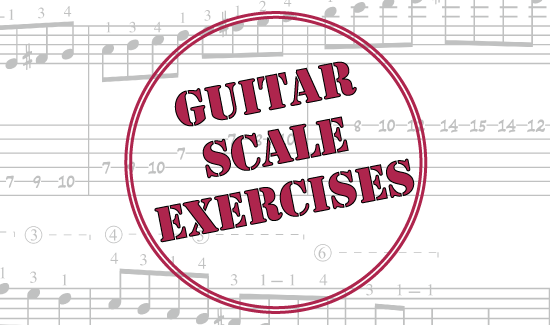These guitar scale exercises can be used to practice changing position and combining scale shapes while improvising.
If you always stay in one position while soloing you may be restricting yourself. Your fingers will fall into the same old patterns and you'll struggle to come up with anything new.
By learning scales all over the fretboard you can give your lead playing more freedom. Even if you are using the same notes but played in a different position you will find that new licks will present themselves.
This lesson will show you how to play 3 octave major scales, how to combine scale shapes while soloing and at the end gives you an extended position-changing study. It is part of the how to get better at guitar series.
3 Octave Scales Exercises
If you stay in one position while soloing you are limited to 2 octaves at most.
In many instances this is adequate: there's no rule that says you should play solos that span multiple octaves.
However, it's good to be able to do it when you need to. If your inner ear wants you to play higher or lower than your current position allows, then you should be able to change position smoothly in mid-solo.
[ad name="Google Adsense Lge Rec"]
Below are two ways of playing a 3 Octave G Major Scale. Although the notes are the same, you can see how the first version has a lot of small position changes, while the second has fewer, with one large jump at the top of the scale.
Practice playing both versions, then try playing some improvised lines using the scales.
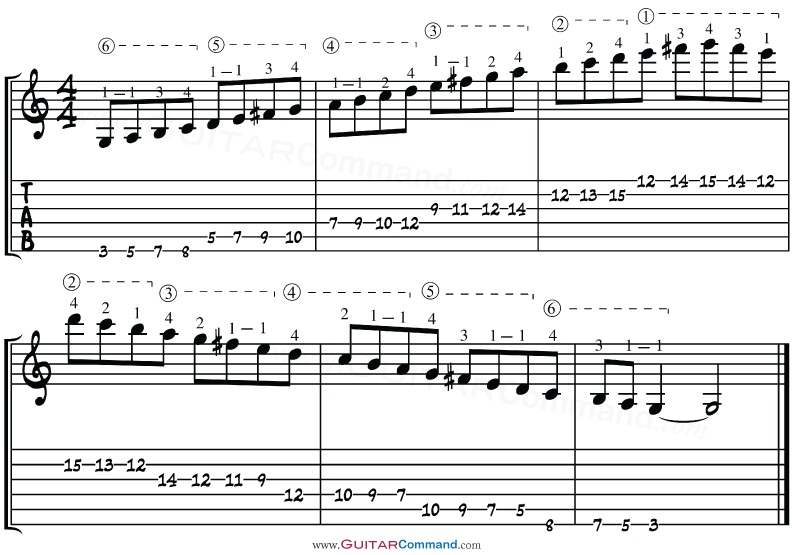
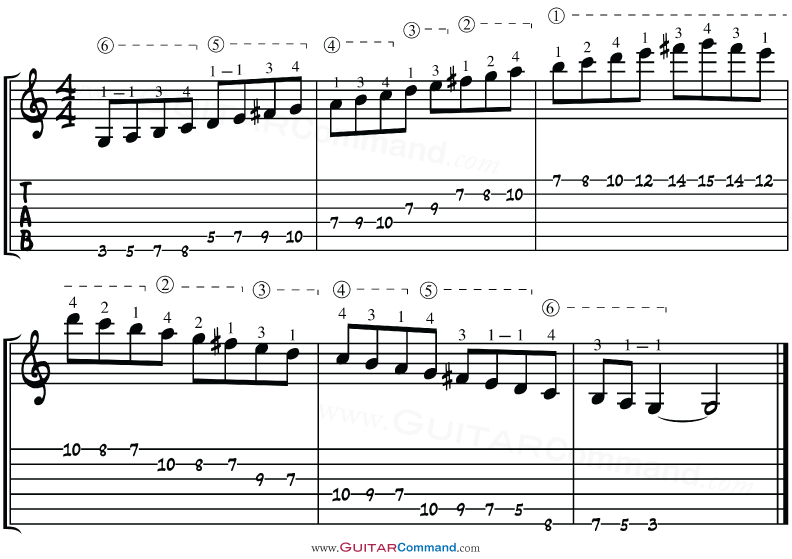
Either way of playing the scale is correct: the second version has fewer position changes but has a large jump towards the end.
Fretboard Position Definition
The fretboard 'position' at which you are playing means the fret that your first finger is positioned over.
Traditional guitar technique says that if you are, for example, playing in fifth position, then your first finger will play any notes at the 5th fret, your second finger the notes at the 6th fret, your third finger the notes at the 7th fret and your fourth finger the notes at the 8th fret.
Although there will be many times in which your fingers will be spread wider than the four frets, when at rest they should be positioned so that they are ready to play at these frets.
[ad name="Google Adsense Lge Rec"]
Most guitar scale diagrams follow this system, and show the notes of a scale in one position, or centered around one position; i.e. covering just four or five frets. A typical scale diagram is shown below.

The diagram shows a scale shape. Different scale shapes can be used to show how the same scale can be played at different fretboard positions (see the 5 major scale shape diagrams below).
Changing Fretboard Position While Soloing
You should become used to changing fretboard position while soloing. You are aiming for smooth lines in which the position changes are undetectable.
In scale-based lines, most of the time you will be using either the 1st or the 4th finger to slide up or down into the new position.
A good tip for changing fretboard position while soloing is to try to move up to the new position with the 1st finger and move down with the 4th finger. This will help to prevent you from 'running out of fingers' and having to make unnecessary slides.
However, systems like this don't always work in practice, and the only right way is the one that allows the smoothest position changes. You should aim to know each scale shape and how they relate to each other.
Five major scale shapes are shown below. In these diagrams the white circles represent the tonic notes of the scale.
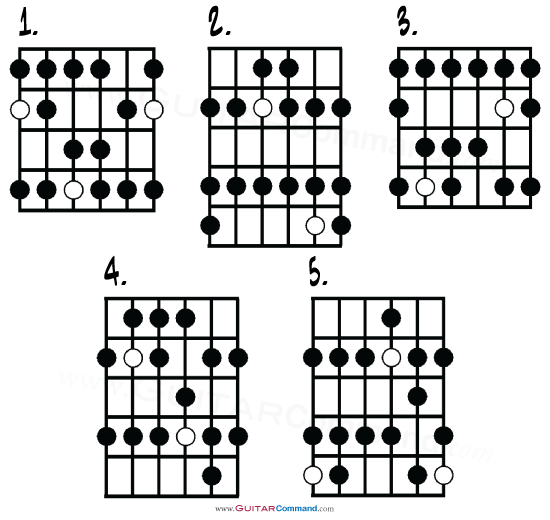
To use these scale shapes to play a G major scale, play them at the following positions:
Shape 1 in 2nd position (i.e. so the first white circle is positioned over the G at the 3rd fret of the 6th (low E) string,
Shape 2 starting in 5th position,
Shape 3 in 7th position,
Shape 4 starting in 9th position,
Shape 5 starting in 12th position.
Note that shapes 2, 4 and 5 require position changes.
Practice improvising phrases that combine 2 or more shapes.
Guitar Scale Exercises
Below are two great exercises that take you through all five major scale shapes. The notes are the same in each exercise, but the fingering and position changes are different.
These exercises allow you to refine your 'position changing technique' at any point in the scale. They will also help you to memorize the different scale shapes.
View / Download a pdf of these exercises here: Scale Position Changing Exercises PDF
Be sure to follow the fingering, position and string markings.
• Fingering is shown as small numbers above the notes / tab
• The fretboard position you should be playing in is shown in Roman numerals
• String numbers are shown in small circles
Position Changing Exercise 1

Position Changing Exercise 2
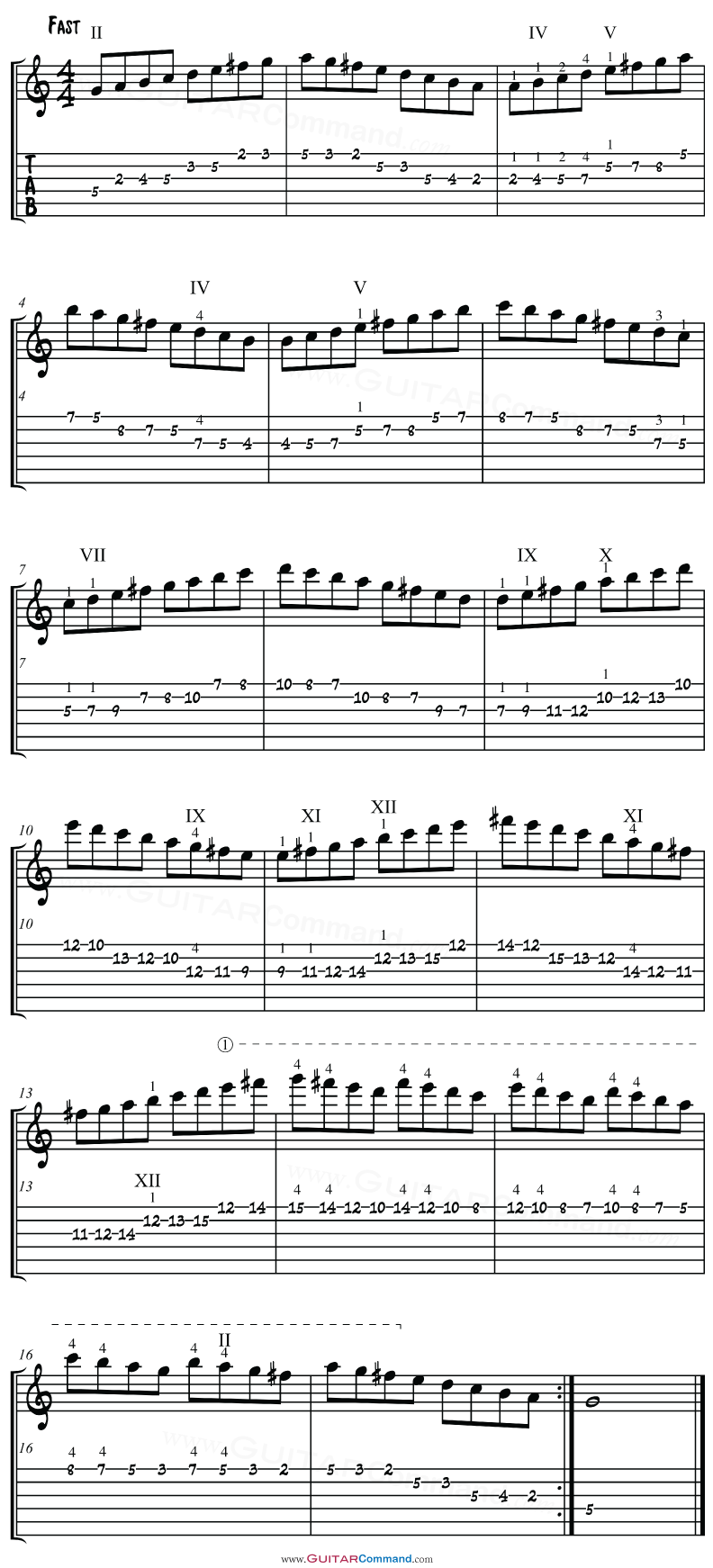
Play the exercises with a metronome: take them slowly at first, then increase the tempo until you are playing just out of your 'safety zone', then reel it in a bit. Work on smooth position changes rather than outright speed.
As you play each exercise note which scale shape you are using and where it begins and ends.
Further Study
Check out this article on 3 note per string scale shapes.
Try out some of the concepts discussed in this article with different scales. Guitar Command have published a guitar scale reference book that contains scale shapes and tab for a large number of scales. It's a great book to have around when you're practicing or if you need some inspiration. Check it out here: Guitar Scale Book.

